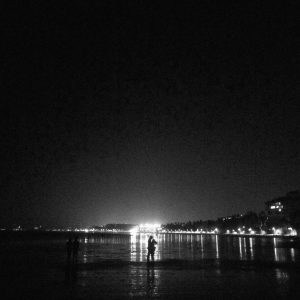At a time when the virtual space is inundated with photographs, and the meaning of a photograph is constantly evolving, does a picture still tell a thousand stories? Asks, Esha Chaudhuri
By Esha Chaudhuri
 World Photography Day is celebrated on August 19 to mark the brilliance of capturing moments within split seconds. Entailing varied themes and genres, photography in the modern times has earned a reputation of being categorised as a distinctive art form, persuading its audience to ponder, reflect and opine on said subjects. Beginning as a day to mark the invention of methods of capturing permanent images on a light-sensitive surface, the first ever
World Photography Day is celebrated on August 19 to mark the brilliance of capturing moments within split seconds. Entailing varied themes and genres, photography in the modern times has earned a reputation of being categorised as a distinctive art form, persuading its audience to ponder, reflect and opine on said subjects. Beginning as a day to mark the invention of methods of capturing permanent images on a light-sensitive surface, the first ever  photographic process was developed by the Frenchmen Louis Daguerre and Joseph Nicephore Niepce in 1837. With the passage of time, accompanied by many other technological breakthroughs in the field – colour photography and then the digital, the scope and aim of the art has magnified. This is especially cemented with the age of digital media, where social networking platforms make almost everyone a skilled/artsy photographer. Easy to manoeuvre, quick to make edits, and the usage of filters allows most to share snippets from their everyday or even momentous times. Sunday Shillong explores what it means to
photographic process was developed by the Frenchmen Louis Daguerre and Joseph Nicephore Niepce in 1837. With the passage of time, accompanied by many other technological breakthroughs in the field – colour photography and then the digital, the scope and aim of the art has magnified. This is especially cemented with the age of digital media, where social networking platforms make almost everyone a skilled/artsy photographer. Easy to manoeuvre, quick to make edits, and the usage of filters allows most to share snippets from their everyday or even momentous times. Sunday Shillong explores what it means to  click photographs of value, depth and consequence. This idea is further enriched by the inputs shared by Anurag Banerjee (31), resident of Shillong and photographer, who says that one does not necessarily need a professional camera to ace photography.
click photographs of value, depth and consequence. This idea is further enriched by the inputs shared by Anurag Banerjee (31), resident of Shillong and photographer, who says that one does not necessarily need a professional camera to ace photography.
 Commenting on the growth within the field from the battery operated, reel induced camera to the digital and high resolution phone cameras, Banerjee says, “What the cellphone has done is that it has put a camera in every pocket, thereby making photography more accessible and democratic than it ever was. So, in my opinion, that is only a good thing and the advancement of technology has benefited photography more than it harms.”
Commenting on the growth within the field from the battery operated, reel induced camera to the digital and high resolution phone cameras, Banerjee says, “What the cellphone has done is that it has put a camera in every pocket, thereby making photography more accessible and democratic than it ever was. So, in my opinion, that is only a good thing and the advancement of technology has benefited photography more than it harms.”
 True, the avenue of photography as a club has expanded its horizons. Ranging from photojournalism to bloggers and vloggers, the essence of photography has broken many walls. As per statistics, on an average there are 95 million uploads of photos and videos on Instagram alone everyday with 2.5 billion active users as of March 2023. These figures can be explained by the ease of
True, the avenue of photography as a club has expanded its horizons. Ranging from photojournalism to bloggers and vloggers, the essence of photography has broken many walls. As per statistics, on an average there are 95 million uploads of photos and videos on Instagram alone everyday with 2.5 billion active users as of March 2023. These figures can be explained by the ease of  navigation and freedom to explore different genres, at times exacerbated by peer pressure, the digital age consumption of such nuggets has grown exponentially even on other forums. On the other hand, it also baffles one on the utility of it. With a thin line separating ‘real’ art forms from those that are in a never ending race to seek validation through followers, likes, comments and ultimately aiming for algorithms, these spaces can be a murky space. In fact, the power of images can sometimes also be undermined through the ‘selfie culture’ and other trends that possess the power to ‘influence’ in an age of social media influencers a certain narrative, or even manipulate opinions and forms.
navigation and freedom to explore different genres, at times exacerbated by peer pressure, the digital age consumption of such nuggets has grown exponentially even on other forums. On the other hand, it also baffles one on the utility of it. With a thin line separating ‘real’ art forms from those that are in a never ending race to seek validation through followers, likes, comments and ultimately aiming for algorithms, these spaces can be a murky space. In fact, the power of images can sometimes also be undermined through the ‘selfie culture’ and other trends that possess the power to ‘influence’ in an age of social media influencers a certain narrative, or even manipulate opinions and forms.
 Instagram’s evolution from capturing and sharing photographs to almost creating a cultural overhaul in terms of consumption of content to sharing of content. While the digital space has now become a converging point for users to share popular culture – fashion, music, makeup, influencers to float a narrative on it. Renowned celebrities too, put their lives out there, almost selling the celluloid culture, Instagram, as a platform has introduced features extending the idea of a photograph (a modality of art to exist forever) to live a life within so many hours, through a ‘story’ or even curating a list among followers and friends, within categories of ‘close friends’, as well as restricting views. Instagram, the most popular social media platform for showcasing photography has structured, and improvised its appearance to cater to all kinds of users and audience.
Instagram’s evolution from capturing and sharing photographs to almost creating a cultural overhaul in terms of consumption of content to sharing of content. While the digital space has now become a converging point for users to share popular culture – fashion, music, makeup, influencers to float a narrative on it. Renowned celebrities too, put their lives out there, almost selling the celluloid culture, Instagram, as a platform has introduced features extending the idea of a photograph (a modality of art to exist forever) to live a life within so many hours, through a ‘story’ or even curating a list among followers and friends, within categories of ‘close friends’, as well as restricting views. Instagram, the most popular social media platform for showcasing photography has structured, and improvised its appearance to cater to all kinds of users and audience.
 In the age of Instagram then, Banerjee was asked how does one differentiate between professional and amateur photography? To which he says, “Instagram has allowed the maker of work to build and communicate directly with an audience, jumping the walls of galleries and curators and gatekeepers. This has never happened before in the history of the photo world or art world. There is also an incredible community of artists on Instagram, each learning from and feeding off others, which is only a good thing. As for differentiating between professional and amateur work – for whom it matters, they’d know.”
In the age of Instagram then, Banerjee was asked how does one differentiate between professional and amateur photography? To which he says, “Instagram has allowed the maker of work to build and communicate directly with an audience, jumping the walls of galleries and curators and gatekeepers. This has never happened before in the history of the photo world or art world. There is also an incredible community of artists on Instagram, each learning from and feeding off others, which is only a good thing. As for differentiating between professional and amateur work – for whom it matters, they’d know.”
Banerjee, who embarked on his photographic journey in his college years in Symbiosis, Pune was impressed by the works of Prabuddha Dasgupta. With his first DSLR – a Nikon D3000 in 2010, he turned a new leaf.
Through his work, he tries to explore the intersection of the personal and the political and believes that as humans, the ability to unlearn things that we’ve been conditioned to believe and by keeping an open mind. “I am also now aware of photography’s power as an introspective tool and I often use it, and text, to look inwards and situate myself in the context of the world around me.” states Banerjee. Adding to this, on being asked if there is an issue(s) in the present discourse that he feels strongly about that translates into his works, he says, “I am focussed on confronting my own identity and its many layers, and peeling them. Everything I do, is, in some way or another, connected to this.”
Banerjee, whose body of work encapsulates feelings of nostalgia during his time away from home (Shillong), longing for his home through the book “I’m not here”. Elaborating on its concept, Banerjee says, “ Even though consisting of a few pieces of text, it is a photo book that I began in 2014 trying to document my hometown, Shillong and my absence here.” Through a span of seven years towards its completion, he explains “It took me all those years and a lot of growing up to understand what it is that I was trying to say through the book. I realised that I wanted to portray a more universal idea of home and not just my home. Eventually, I realised that what I wanted to go after is what James Baldwin says in his heartbreaking book “Giovanni’s Room” – perhaps home is not a place but simply an irrevocable condition. The book opens with this quote and is my search for my irrevocable condition.”
Growing up in Shillong, having studied in St. Edmund’s School, Shillong shaped his bent of mind to find everything home-like in Shillong. When he moved to Mumbai, as most from smaller towns do, the city’s fast ways sometimes didn’t make it a cakewalk for him at first, but at the same time, also gave him perspective on life and eventually led him to the community of people, mentors and friends. Reminiscing ‘home’ associated with Shillong, Mumbai also became his home. Banerjee says, “Even with my growing disillusionment with life in the big city as Mumbai will always also be home. The city showed me how big this world is and was a window to this world for me.”
In other notable works, Banerjee also found himself in a project by Payal Khandwala (Mumbai based artist turned designer since 1989) titled ‘Women in Shillong’.
“Khandwala, the women’s design fashion label contacted me last year with this project through which they wanted to do an honest portrayal of the contemporary Indian woman, breaking stereotypes from across the country.”
“Along with them, I gradually began developing the idea and we zeroed in on beautifully printed zines. Doing this in Shillong was yet another way for me to assert my identity with the place and was able to photograph some women of my hometown.” adds Banerjee.
To weave it altogether, photographs are a powerful tool for storytelling that words sometimes cannot. Banerjee concurs, “Very few other mediums have seen such rapid advancements as photography has. There was never a time before when more photographs were being made, or this medium was more democratic. In my own work, text has become as important a part as photography is, which adds another layer to it.”
Banerjee’s entry into the medium was through documentary photography with his first body of work, “Love in Bombay” documented intimacy in public spaces in Mumbai, his ode to the city he is still learning to love. With time, Anurag has gradually begun understanding the power of photography as an introspective tool. “I’m not here” evolved with this understanding, an idea that became an irrevocable condition. Today, Anurag uses photography, and text, as a way to understand and situate himself within the context of the world around him.
Wearing shades of colour as well as greys, photographs illustrate stories of people, their lands, their histories, their ancestors, their politics, and of course, joyous moments, most often beyond what is visible.



